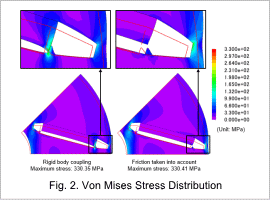*Please prepare a license ID and password for the license administrator.
*It is different from the service for JMAG WEB MEMBER (free membership). Please be careful.
Overview

The centrifugal force generated when an IPM motor rotates at high speeds presses the magnets into the rotor core. The friction caused by the magnet slip produces significant stress in parts. Stress that surpasses the yield point results in plastic deformation that can reduce motor performance or damage parts. That is why it is critical during the design stage to ensure the stress produced by the centrifugal force does not exceed the yield point.
Simulations can evaluate the influence of centrifugal force to reflect those characteristics in a design before ever fabricating an actual product. In particular, accurate modeling of contact between parts and any plastic deformation is key to obtain truly trustworthy analysis results.
This case study compares the von Mises stress obtained by two analysis cases to evaluate the influence the contact between the magnets and rotor core of an IPM motor have on the stress distribution. One analysis case uses a rigid-body model. The other uses a model that accounts for contact as the magnets slip.
Simulations can evaluate the influence of centrifugal force to reflect those characteristics in a design before ever fabricating an actual product. In particular, accurate modeling of contact between parts and any plastic deformation is key to obtain truly trustworthy analysis results.
This case study compares the von Mises stress obtained by two analysis cases to evaluate the influence the contact between the magnets and rotor core of an IPM motor have on the stress distribution. One analysis case uses a rigid-body model. The other uses a model that accounts for contact as the magnets slip.
Material Properties of Rotor Core

Fig. 1 outlines the material properties of the rotor core. The yield stress of the material used for the rotor core is 330 MPa.
Von Mises Stress Distribution

Fig. 2 scales up the deformation 200% and visually compares the von Mises stress. The rigid body model has significant stress concentrating at surfaces that have contact due to the static stress of the magnets and rotor core. However, the model that accounts for the contact shows that the stress tends to concentrate in the bridges due to the tangential slip of the magnets in contact with the rotor core.
The difference in contact between a rigid body model and one accounting for the contact greatly influences the stress distribution. The actual phenomenon never has completely static stress between parts that have contact. There is always some slip. That is why properly modeling the contact between parts is essential to precisely evaluate stress.
Moreover, plastic deformation of the geometry can deteriorate motor characteristics and potentially cause damage if the maximum von Mises stress exceeds the yield point of 330 MPa. Designers must consider measures to reduce stress, such as modifying the materials or structure.
The difference in contact between a rigid body model and one accounting for the contact greatly influences the stress distribution. The actual phenomenon never has completely static stress between parts that have contact. There is always some slip. That is why properly modeling the contact between parts is essential to precisely evaluate stress.
Moreover, plastic deformation of the geometry can deteriorate motor characteristics and potentially cause damage if the maximum von Mises stress exceeds the yield point of 330 MPa. Designers must consider measures to reduce stress, such as modifying the materials or structure.


